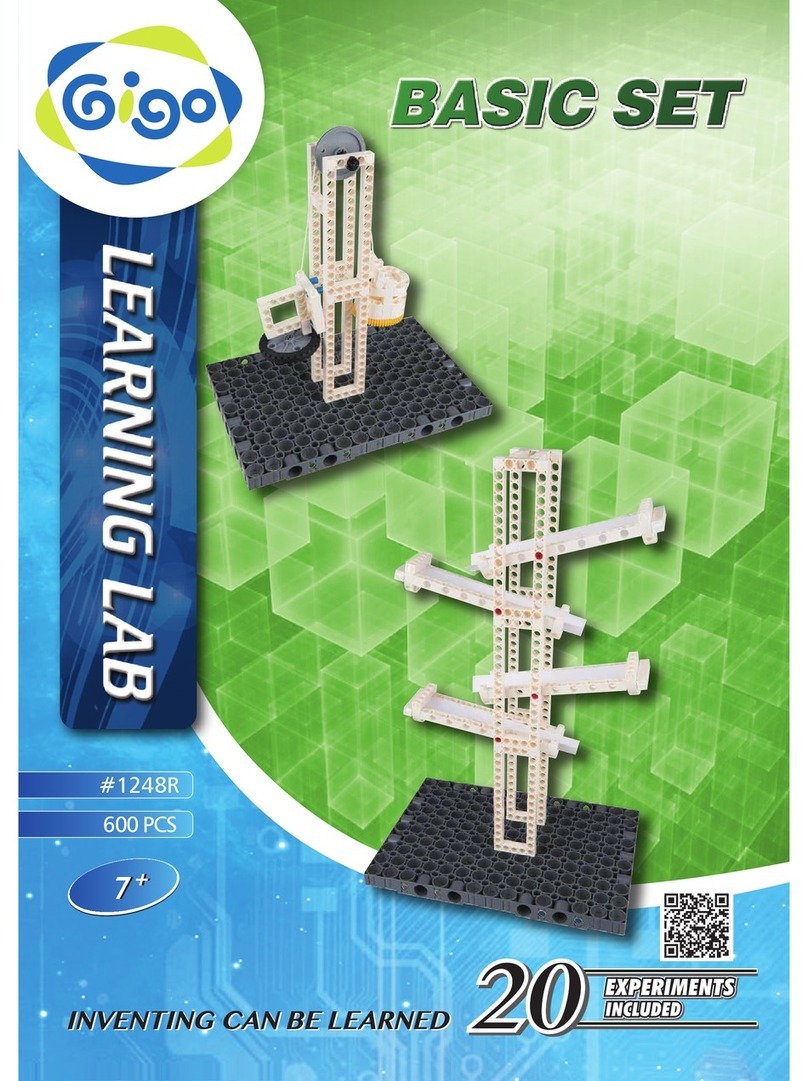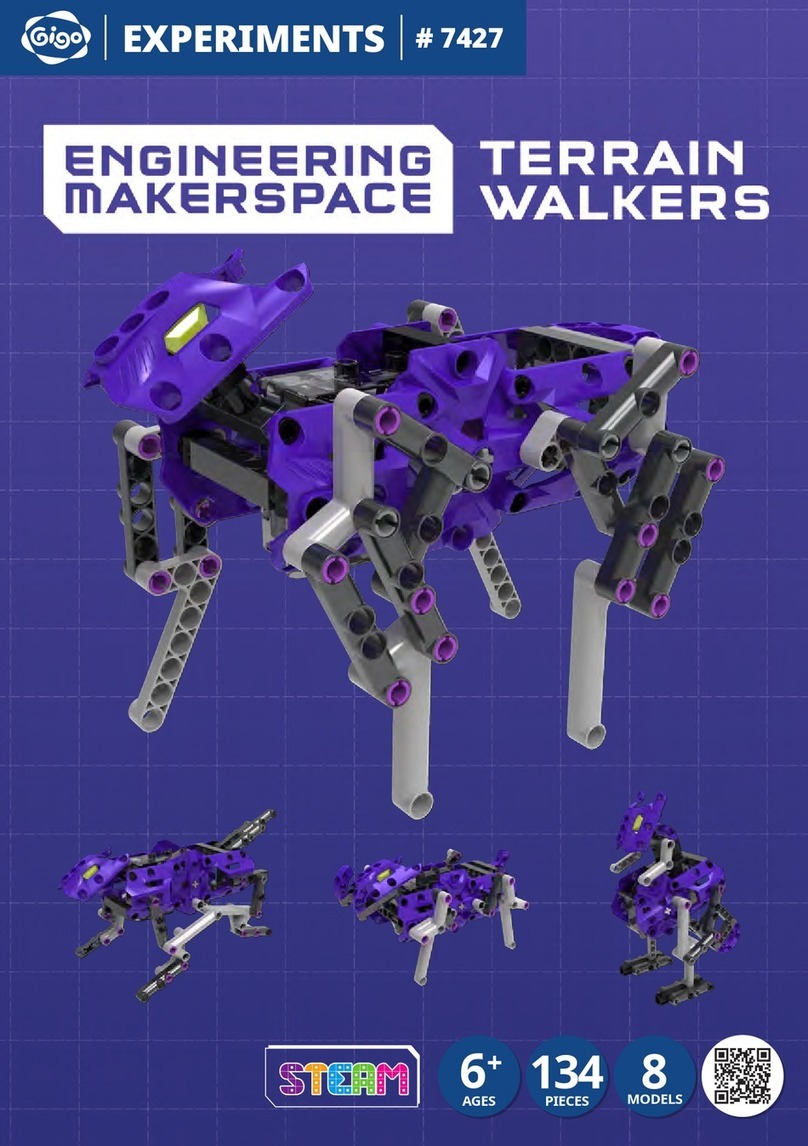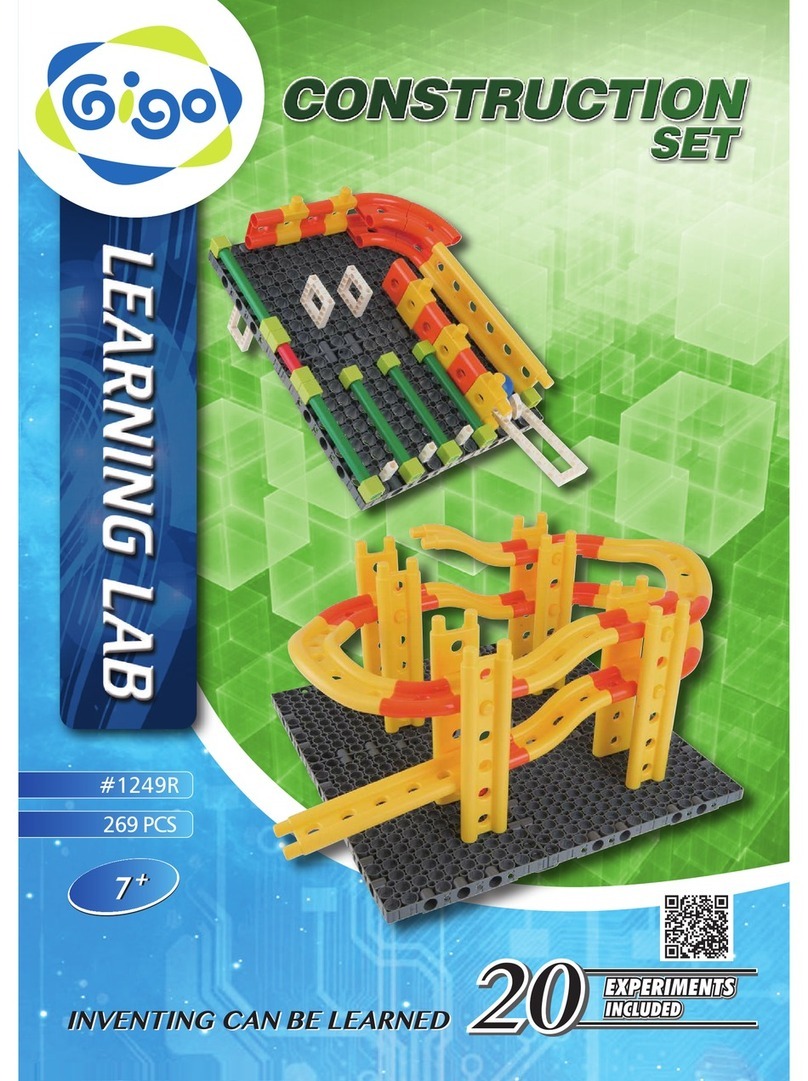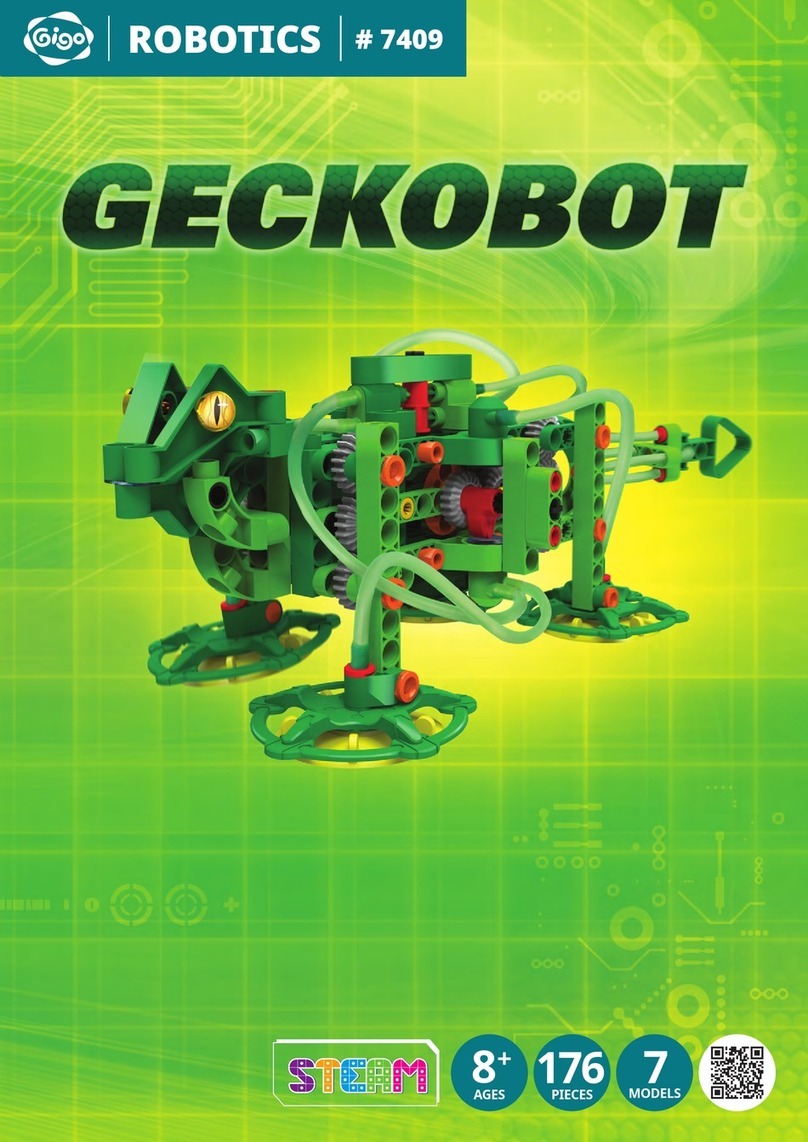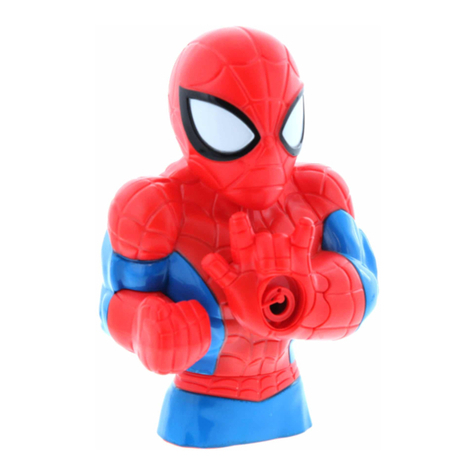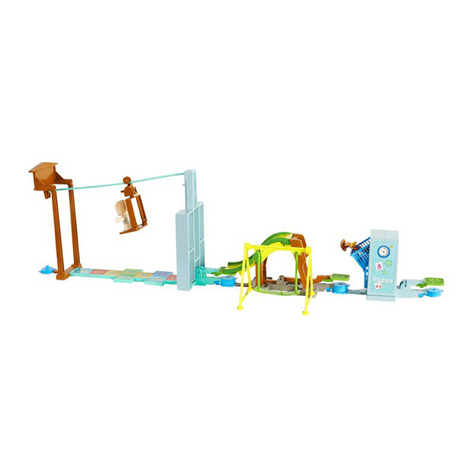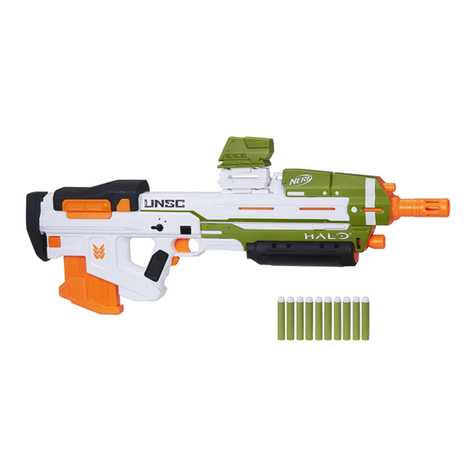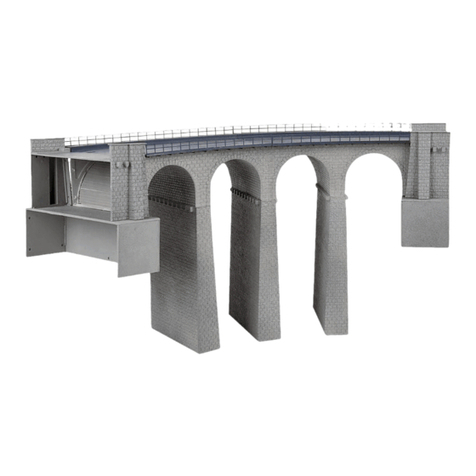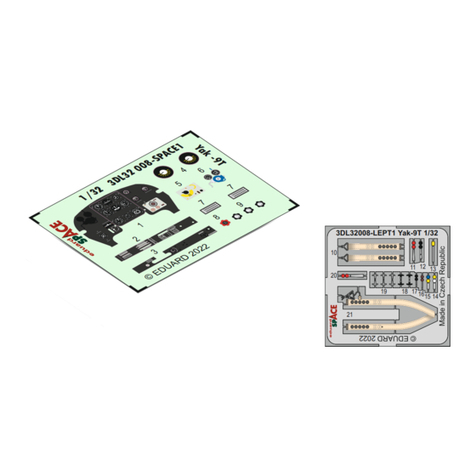Gigo EXPERIMENTS 7335RR User manual

# 7335RR
EXPERIMENTS
151
PIECES
8
+
AGES
20
MODELS

01 Contents
Contents/Safety Information
Parts List
About Remote Control Machines
About Gigo Gears
Model 1
Model 2
Model 3
Model 4
Model 5
Model 6
Model 7
Model 8
Model 9
Model 10
Model 11
Model 12
Model 13
Model 14
Model 15
Model 16
Model 17
Model 18
Model 19
Model 20
P1 to P2
P3
P4 to P5
P6 to P9
P10 to P12
P13 to P17
P18 to P19
P20 to P24
P25 to P28
P29 to P33
P34 to P38
P39 to P43
P44 to P48
P49 to P54
P55 to P59
P60 to P64
P65 to P70
P71 to P73
P74 to P76
P77 to P81
P82 to P86
P87 to P91
P92 to P96
P97 to P102
FCC Statements:
This device complies with part 15 of the FCC rules. Operation is
subject to the following two conditions:
1) This device may not cause harmful interference
2) This device must accept any interference received, including
interference that may cause undesired operation.
NOTE:
This equipment has been tested and found to comply with the limits
for a Class B digital device, pursuant to Part 15 of the FCC Rules.
These limits are designed to provide reasonable protection against
harmful interference in a residential installation. This equipment
generates, uses and can radiate radio frequency energy and, if not
installed and used in accordance with the instructions, may cause
harmful interference to radio communications.
However, there is no guarantee that interference will not occur in a
particular installation. If this equipment does cause harmful
interference to radio or television reception, which can be determined
by turning the equipment off and on, the user is encouraged to try to
correct the interference by one or more of the following measures:
-Reorient or relocate the receiving antenna.
-Increase the separation between the equipment and receiver.
-Connect the equipment into an outlet on a circuit different from that
to which the receiver is connected.
-Consult the dealer or an experienced radio/TV technician for help.
Safety Precautions
-Parents, this toy is recommended for children 8 years and older.
To ensure that your child’s play is both safe and fun, please review
the operating instructions with your children. If toy in the presence
of children under 3 years of age, adult supervision is recommended.
-Keep hands, hair and loose clothing away from the tires and the
wheel hubs when power switch is turned ON.
-Remove battery from the toy when not in use.
-DO NOT operate your vehicle on street. Avoid hitting people, pets
or home furnishings.
-Warning: Changes or modifications to this unit not expressly
approved by the party responsible for compliance could void the
user’s authority to operate the equipment.
P
P
P
P
P
P
P
P
P
P
P
P
P
P
P
P
Three Wheel Car
Large Truck
Mini Sport Car
Ball Collecting Cart
Folding Car
Stag Beetle Car
Elevator
Crane
Stacker
Truck
Scissor Lifter
Bulldozer
Drill Machine
Mining Machine
Bat
Soccer Robot Game
Robot
Aircraft
Stag Beetle
Robot Arm

02
Safety Information
Cautions:
-Non-rechargeable batteries are not to be recharged.
-Rechargeable batteries are to be removed before being charged.
-Rechargeable batteries are only to be charged under adult supervision.
-Different types of batteries or new and used batteries are not to be mixed.
-Only batteries of the same or equivalent type as recommended are to be
used.
-Batteries are to be inserted with correct polarity.
-Exhausted batteries are to be removed from the toy.
-The supply terminals are not to be short-circuited.
Note:
-Parental guidance is recommended when installing or replacing batteries.
-New and alkaline batteries are recommended to use in this toy to obtain best
and maximum performance.
-You are advised to replace with new batteries as soon as the function
becomes impaired.
-Users should keep and retain this information for future reference.
-Users should keep strict accordance with the instruction manual while
operation the product.
Care and Maintenance:
-Always remove batteries from the toy when it is not being used for a long
period of time.
-Wipe the toy gently with a clean damp cloth.
-Keep the toy away from direct sunlight and/or direct heat.
-Do not submerge the toy into water that can damage the electronic
assemblies.
The crossed-out dustbin symbol indicates that batteries,
rechargeable batteries, button cells, battery packs, etc.
must not be put in the household waste. Batteries are
harmful to health and the environment. Please help to
protect the environment form health risks. If the toy is out
of use, please use common household tool to break the
product for built-in rechargeable battery operated toy or
unscrew the battery door for replaceable battery operated
toy, then take the battery out from the toy. Dispose of
battery in accordance with your local battery recycling or
disposal laws.
Waste Electrical and Electronic Equipment (WEEE)
When this appliance is out of use, please remove all
batteries and dispose of them separately. Bring electrical
appliances to the local collecting points for waste electrical
and electronic equipment. Other components can be
disposed of in domestic refuse.
ĸ
Remote Controller
+
_
+
+
_
_
ĸ
Receiver/Battery Holder
Insert three AA batteries (1.5 V) into the combination receiver/battery holder. The
polarity of the batteries and the markings on the battery compartments should match. 1.Lightly press and slide
the lid outward to open it.
2. Insert two AA batteries (1.5 V)
and pay attention to the polarity
of the batteries and the
markings on the compartments.
3. Slide back the lid.

03 Parts List
1 REMOTE CONTROLLER
2 RECEIVER/BATTERY HOLDER
3 PEG/AXLE REMOVER
4 POWER PACK WITH WIRE CONNECTOR
5 3-HOLE ROD
6 5-HOLE ROD
7 ROD
8 3-HOLE DUAL ROD
9 DUAL ROD
10 SQUARE FRAME
11 SHORT FRAME
12 DUAL FRAME
13 BENDED ROD
14 WORM GEAR II
15 S GEAR
16 M GEAR
17 L GEAR
18 80T GEAR
19 RACING TIRE
20 ROD CONNECTOR
21 90 DEGREE CONVERTER-L
22 90 DEGREE CONVERTER-R
23 TWO-IN-ONE CONVERTER
24 MOTOR AXLE
25 S DR. AXLE 3 CM
26 7CM DR. AXLE
27 XL DR. AXLE 15 CM
28 AXLE
29 GEAR FIXING
30 CAM CONNECTOR
31 PEG
32 HINGE
33 AXLE CONNECTOR
34 SHELL HALF QUARTER CURVE
35 SHELL HALF CURVE
36 SHELL SIDE CURVE LEFT
37 SHELL SIDE CURVE RIGHT
38 EYE-2
39 HORN
40 EXTRA LOOSE PEG
41 STRING
42 S PULLEY
43 O RING S
1
1
1
3
3
6
8
4
6
4
3
3
2
3
4
2
2
1
4
2
4
2
6
4
2
3
1
2
2
2
28
2
10
1
2
1
1
2
2
8
1
1
1
NO PCS
PARTS NAME

04
About Remote Control Machines
A. REMOTE CONTROLLER
1. Operating Principle
Fig. 2 The front side of the remote controller Fig. 3 The back side of the remote controller
Touch Pad
LED
IR Projector
Speaker
Switch
Insert two 1.5V size AA
batteries Press and slide
the lid outward
to open it.
This kit offers children a new experience with remote control toys. It incorporates
a touch pad remote-controller and three geared motors into a set of building
components. Children can use the building blocks to construct a series of
machines, and then control them using the six capacitive sensors (touch pads)
on the remote control. This kit allows children to create models and learn about
electricity, physics, and mechanics in a hands-on way.
Fig. 1 shows you the electronic parts of this kit, which include:
A. Remote Controller
B. Receiver/Battery Holder
C. Power Pack With Wire Connector
When the user’s finger makes contact with
the touch pad on the remote controller, the
capacitance will change. The driver IC
(integrated circuit) of the touch pad
determines the amount the capacitance
has changed and coverts it into
coordinates (X, Y, θ angel). In this way, the
touch pad is able to detect the movement
of fingers. The touch pad is not only easy
and flexible to use, but environmentally
friendly because it reduces the electronic
elements needed for assembly.
The remote controller uses an infrared beam to send control signals
to the receiver. It is directional (the infrared beam has to be aimed
toward the receiver) and has a short-distance range (about 20 feet,
or 7 meters, in general).
The three sets of touch pads correspond to the three outputs on the
receiver/battery holder from left to right. Each set of touch pads
controls the rotation of the corresponding output motors, on turning
them clockwise and the other counterclockwise. When the touch pad
is touched and the signal received, the speaker and the LED will
produce sound and light effects.
The user can touch three touch pads (one in each set) at the
same time so that the three corresponding output motors can
all be activated at the same time. However, touching the two
touch pads at the same set simultaneously won’t cause any
action because the motor cannot move forward and in
reverse at the same time.
Two AA batteries (1.5V) are needed. Set the switch to OFF
when not in use in order to save energy.
Fig. 1 The Remote-Control Machines system
C. Power Packs B. Receiver/Battery Holder A. Remote Controller
Power Pack 3
Power Pack 3
Power Pack 3
Power Pack 2
Power Pack 2
Power Pack 2 Power Pack 1
Power Pack 1
Power Pack 1
Output 2
Output 2
Output 2
Row 1
Row 1
Row 1
Output 1
Output 1
Output 1
Output 3
Output 3
Output 3
Row 2
Row 2
Row 2
Row 3
Row 3
Row 3
2. IR Remote Control (Infrared Remote Control):

05 About Remote Control Machines
MOTOR Set A Set B Set C AXLE X
B. RECEIVER/BATTERY HOLDER
IR IC Receiver
Three Electricity Outputs
Fig. 5 Fig. 6
The interior structure of the geared motor with wire connector is shown of Fig. 5 and Fig. 6. When the motor is activated, the power
is transmitted from the motor to the gearbox, which contains three gear sets: Set A gives a gear ratio 20 to 8, Set B gives a gear
ratio 28 to 8, and Set C gives a gear ratio 30 to 8. The overall gear ratio of the system is 20/8 x 28/8 x 30/8; that is, 32.8125 to 1. In
other words, the motor has to turn 32.8125 times to turn the axle X once. If the motor turns at 3200 rpm, the axle X in this system will
turn at 100 rpm. In other words, the speed of the axle X will decrease by 32 times but the torque (turning force) will increase by 32
times.
C. GEARED MOTOR WITH WIRE CONNECTOR
MOTOR
20T
28T
30T
8T D
C
B
A
When the IR receiver receives a message from the remote controller, the built-in IC chip will judge which
corresponding touch pads were touched and then convert the control message into the corresponding
electrical outputs. Three AA batteries (1.5 V) are set in series in the receiver/battery holder. Each output
gives a 3 V direct current.
This kit introduces children to the principles of wireless communications and remote control technology
with this simple IR remote-control device that has three corresponding normal outputs. It instructs
children to build specific models with different remote-control functions, and encourages them to design
and build their won models using their creativity. The models can each incorporate up to three motors
which can be installed in different ways to allow the models to move in six directions (that is, forward or
backward, left or right, up or down).
When you finish playing with this kit, please remove one of the batteries from the receiver/battery holder because the receiver/battery
holder will still consume some electricity even in a standby. This will save energy and keep it safe.
Fig. 4 Receiver/Battery Holder

06
About Gigo Gears
Gears are wheels with teeth on them. The teeth, or cogs, of one gear mesh with the teeth of another gear to transmit force between them.
A combination of two or more gears is called a transmission, or gear train. You can see transmissions with meshing gears inside old toys
or old clocks. Gearboxes can be found inside the transmission system of cars, which combine meshing gears of different sizes. This allows
the car’s driver to easily change between different speeds.
Do you know how gears work? You can learn how gears work and why they are useful by reading this manual and building the models in
this kit that use gears. The building blocks in this kit were designed based on the number ten and its multiples, including the size of the
components, the distance between the holes, or the unique gears. This makes it easy to both assemble the gears and also conveniently
calculate the gear ratio or change the rotary speed. Different from other gear designs that use the number seven or eight as their
fundamental number, these gears were created to be perfect for
teaching science to kids because they are easy to assemble and
they make it easy to calculate gear ratios (explained below).
We recommend a gradual learning process using these gears,
which begins with very basic assemblies to understand how each of
the components fit together. After you build all of the models in this
instruction book and understand how to use gear trains, you can
put your unlimited creativity to work and design vehicles and
machines on your won. Let your imagination guide you!
Now let’s look closely at gears and how we use them. Find the
gears in this kit. The wheels which have many tooth-shaped objects
sticking out of their edges are gears. Two gears can mesh with
each others using the teeth on the edges. When one gear rotates,
the other one will be driven to rotate as well. The intermeshing teeth of the two gears transmit torque (turning force) and rotation.
The big gear has more teeth than the small gear. Despite the number of teeth or the size of the gears,
all of the teeth on all of the gears in the same gear system must all be the same size. In simple gear
trains, the driver and driven gears will rotate in opposite directions. When a third gear is inserted
between the driver gear and driven gear, and makes them rotate in the same direction, it is called an
idler gear.
Fig. 8 Gear ratio calculation
Fig. 9 Gigo Gears
GEAR
Fig. 7 The intermeshing of gears can effectively transmit
force to cause rotation. The red circle represents the
actual diameter of the transmission, which is called the
pitch diameter. The special shape of the teeth allows
for smooth intermeshing and transmits power along
the pitch.
40 teeth
driven gear
20 teeth
driver gear
40
20
2
1( 2:1 )
Velocity
ratio
Tooth number of the driven gear
Tooth number of the driver gear
=
= =
▲
160T Gear is not
included in this kit.
20T
40T
60T
80T
160T

07 About Gigo Gears
Fig. 10 Gigo Gear
Fig. 12
Fig. 13
UNDERSTANDING GEARS 1
UNDERSTANDING GEARS 2
The pitch diameter of the gears in this gear system is proportional to the
number of gear teeth. In other words, the pitch diameter of the 20T gears is
20 millimeters while the pitch diameter of the 40 millimeters. Again, the
pitch diameters are the imaginary circles between the meshed gear teeth
as shown in Figure 11.
In Fig. 11, the distance between the centers of the two gears is calculated
like this.
Therefore you can easily place the two gears on a rod or frame so that they
mesh together smoothly. The other sizes of gears are designed with the
same elegantly simple concept, so that all of the gears can easily be
assembled into working gear trains.
According to the instructions above, can you figure out how many holes
there are between a 40T and a 60T gear when they are meshed?
1.
Use a 20T gear, a 40T gear, and two small axles to assemble the structure show in Fig. 12.
2.
How many times do you need to turn gear A to make gear B rotate once?
3.
You will see that when a 20T gear drives a 40T gear, the gear ratio is 2:1,
4.
You will also see that as the teeth of the two gears mesh together, the two gears rotate in opposite directions.
Use two 20T gears, one 40T gear, two small axles, and one medium axle to assemble the structure shown in
Fig. 13.
How many times do you need to turn gear A to make gear B rotate once?
You will see that when a 20T gear drives a 40T gear, the gear ratio is 2:1, i.e. the gear ratio is the number of
teeth on the driven gear divided by the number of teeth on the drive gear.
You will also see that as an idler gear is inserted in between the two gears A and B now rotate in the same
direction.
Fig. 11 The transmission between the pitches
during the intermesh of two gears.
Idler gear
B 40T
A 20T
R1 R2
B
A
i.e. the gear ration=
R1+R2= =30mm+
= =
Tooth number of the driven gear
Tooth number of the driver gear
40
20
20mm
2
40mm
2
2(2:1)
1
1.
2.
3.
4.
If you were to insert two idler gears in between gears A and B instead of just one, in which direction would A
and B rotate?

08
About Gigo Gears
Fig. 14
UNDERSTANDING GEARS 3
Fig. 15
UNDERSTANDING GEARS 4
UNDERSTANDING GEARS 5
Use two 20T gears, two 60T gears, two small axles, and one medium axle to assemble the structure in
Fig. 14.
How many times do you need to turn gear A to make gear D rotate once?
You will see that the gear ratio for the 20T gear A to drive the 60T gear B is 3:1, while the gear ratio for
20T gear C to drive 60T gear D is 3:1.
You will also see that when the axle of compound gears (B and C) is inserted, the first (A) and the
last (D) gears rotate in the same direction.
On the previous structure, add an additional 40T blue gear, a 20T red gear, and a medium axle to
assemble the structure as shown in Fig. 15.
Can you calculate how many times the 20T gear at position X needs to turn in order to make gear D rotate
once?
Turn it yourself, and count how many times it turns. Were your calculations correct?
Fig. 15 shows the gears meshing as bevel gears at right angles. The calculations of gear ratio and the
principles of rotary directions are the same as with spur gears.
Fig. 16 Gigo gears mesh as bevel gears at right angels.
B
B
C
C
40T
20T
D
D
X
X
A
A
90°
Therefore the overall gear ratio = tooth no. of the driven gear/tooth no. of the driver gear =
=
=
60
20
60
20
3
1
3
1
9
1(9:1)
x x
1.
1.
2.
2.
3.
3.
4.
When an additional 20T red-gear is added to the small axle at position X, why can’t the gears rotate?

09 About Gigo Gears
UNDERSTANDING GEARS 6
Worm gears
Fig. 18 Structure of a worm gearbox
Fig. 17
Gear Wheel
Worm Gear
80T
20T
ROTARY GEARBOX
Fig. 19 Fig. 20
The gears in this kit can combine in yet another way. A worm
gear and gear wheel are combined together as a worm
gearbox. As the worm gear rotates once, the gear wheel turns
only a one-tooth distance. Take the 40-tooth blue gear as an
example, the gear ratio would reach 40:1 to achieve a huge
speed reduction and torque increase. When friction is not
considered, the speed reduction reaches 40 times, and the
torque increase 40 times. In addition, the structure of the worm
gearbox also has another characteristic: the transmission can
only be conducted from the worm gear to this characteristic; the
worm gearbox can only be used for speed reduction and not for
speeding up. For this reason, it is commonly used in the
opening device for garage doors to prevent the possibility of the
door dropping unexpectedly.
The examples below illustrate the assembly of the frames,
gears, and axles. The gears are easy to install on the rods and
frames in this kit, because the rods and frames have holes
positioned in increments of ten millimeters. The pitch diameters
are in multiples of 20 millimeters, and thus the distance
between the center points of the gears is in multiples of ten
millimeters.
Fig. 17 is an another examples showing two gears meshing as beveled gears at a right angle.
The 80T Gear with the built-in pitch holes, acts as a rotary stage here on which the frame structure can be built.

10
Model 1 Three Wheel Car
=ñ= =ñ= =ñ= =ñ= =ñ=
=ñ= =ñ=
=ñ= =ñ=
=ñ=
=ñ=
=ñ=
=ñ=
=ñ=
=ñ= =ñ= =ñ=
=ñ=
=ñ= =ñ=
The wheels must be spaced 1 mm away from
the frame so that the wheels can turn smoothly.
If the motor doesn't work, check to make sure
the wire connector of the motor and the output
of the receiver/battery holder are well connect-
ed, or that the batteries are not dead.
Turn on the switch on Remote
Controller.
Touch the touch pad 1 or 4 (in
green ring) on the remote
controller to activate the motor
indicated in Green for back and forth motion.
Touch the touch pad 3 or 6 (in red ring) on the remote controller to
activate the motor indicated in Red for back and forth motion.
Touch the touch pad 1 and 6 or 3 and 4 at the same time to make the
model run around.
We only show number 1 to 6 in the instruction manual, there
shall be no number printed on the remote controller.
1.
2.
3.
4.
How to Operate
1
1
3
3
4
4
6
6
1
2
3
4
5
6
Set a start and an end point on
the ground, and place books,
cups or boxes as obstacles in
between them. Compete with
your friends to see who reach
the goal in less time.
Tips for Assembly
Challenge
*

11 Model 1 Three Wheel Car

12
Model 1 Three Wheel Car

13 Model 2 Large Truck
=ñ= =ñ= =ñ= =ñ= =ñ=
=ñ=
=ñ=
=ñ= =ñ= =ñ==ñ=
=ñ= =ñ= =ñ= =ñ= =ñ=
=ñ= =ñ= =ñ= =ñ= =ñ=
=ñ==ñ=
=ñ= =ñ=
=ñ=
=ñ=
The wheels must be spaced 1 mm away from
the frame so that the wheels can turn
smoothly.
Turn on the
switch on
Remote
Controller.
Touch the touch
pad 1 or 4 (in green ring) on the remote controller to activate the
motor indicated in Green for back and forth motion.
Touch the touch pad 3 or 6 (in red ring) on the remote controller to
activate the motor indicated in Red for back and forth motion.
Design a parking space for
your model and try to back
your model into the
parking spot.
1
2
3
4
5
6
1
4
3
6
1
3
4
6
1.
2.
3.
Tips for Assembly
How to Operate
Challenge

14
Model 2 Large Truck

15 Model 2 Large Truck

16
Model 2 Large Truck

17 Model 2 Large Truck

18
Model 3 Mini Sport Car
=ñ= =ñ= =ñ= =ñ=
=ñ=
=ñ= =ñ=
=ñ= =ñ=
=ñ=
=ñ=
=ñ=
=ñ=
=ñ==ñ=
=ñ=
=ñ= =ñ=
=ñ=
The wheels must be spaced 1 mm away from the
frame so that the wheels can turn smoothly.
Turn on the switch on the remote controller.
Touch the touch pad 2 or 5 (in blue ring) on the remote controller to
activate the motor indicated in Blue for back and forth motion.
2
5
1
2
3
4
5
6
1.
2.
Tips for Assembly
How to Operate

19 Model 3 Mini Sport Car
Table of contents
Other Gigo Toy manuals
Popular Toy manuals by other brands

National Products
National Products Mini Cooper 0582 owner's manual
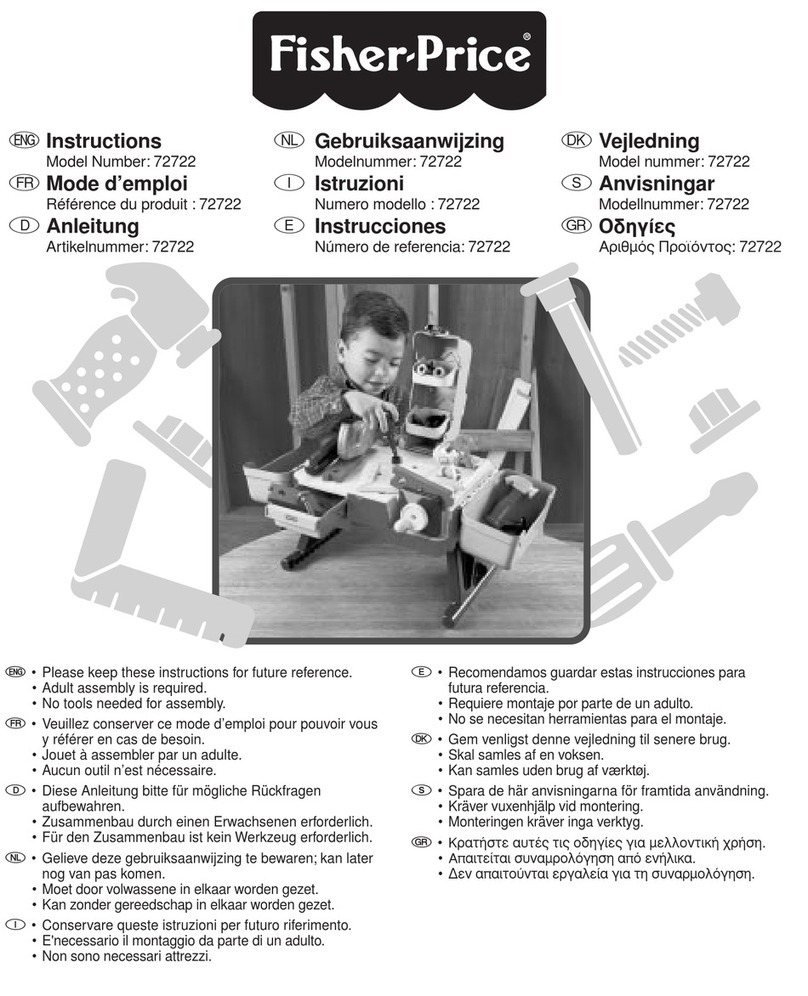
Fisher-Price
Fisher-Price 72722 instructions

LEGO
LEGO Lord Of The Rings 79005 Assembly manual

Hasbro
Hasbro FurReal Friends Butterscotch Pony 76471 care guide
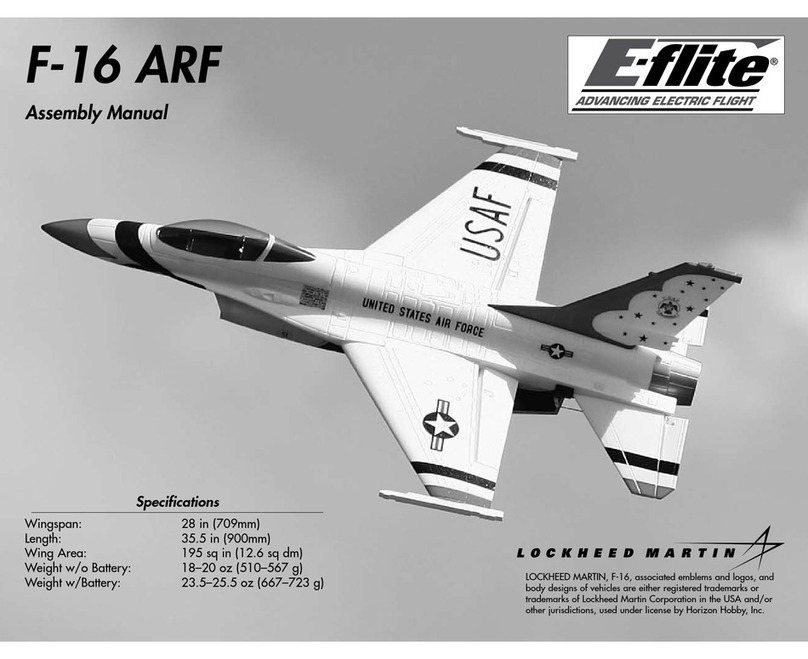
E-FLITE
E-FLITE F-16 ARF Assembly manual
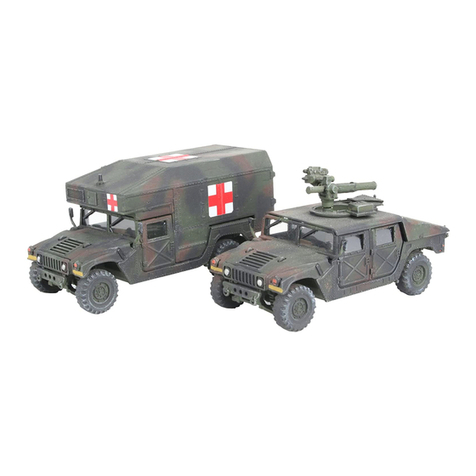
REVELL
REVELL HMMWV M966 TOW Missile Carrier Assembly manual
